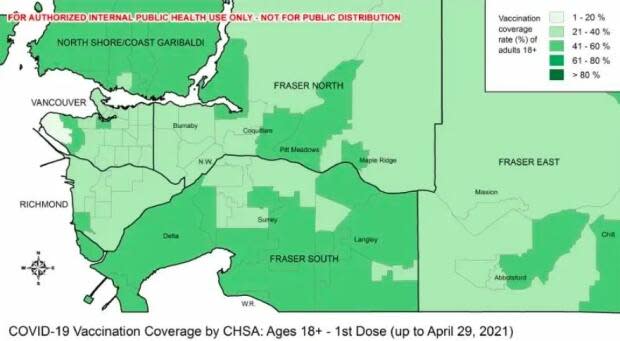B.C. government's pandemic data leak confirms lack of transparency relative to other provinces

Frustration.
That was the broad reaction to the revelation the BC Centre for Disease Control has been providing detailed information on COVID-19 case counts and vaccinations at a neighbourhood-based level in Metro Vancouver — but not releasing it to the public.
"Experts have been asking for this data package for so long, and to find out that it was available but not being shared is really disappointing and really frustrating," said Green Party Leader Sonia Furstenau.
The data, originally leaked to The Vancouver Sun, shows a number of different metrics that journalists and data scientists have long been asking for.
The biggest immediate story was one some had suspected but the government had only hinted at through the partial data it revealed — positivity rates for the virus in the poorest and more diverse neighbourhoods of Surrey were the worst in Metro Vancouver last week, but the per cent of people vaccinated was lower than richer, whiter areas of the Fraser Valley.
It also shows that positivity rates were above 20 per cent in Peace River North last week (the local health area surrounding Fort St. John), while the per cent of people who had been vaccinated was the lowest in the province.
"To really understand geographically, especially in the high transmission areas, what the rates were is really important. It's less about modelling and more about equity issues," said Jens Von Bergmann, a data scientist and member of the BC COVID-19 Modelling Group.
But the leak also shows a broader story of this pandemic: the public not having the same information as the government to help inform its own personal decision making.
"It's frustrating to constantly run into things like this, especially when you see what other provinces provide," said Von Bergmann.

What do other provinces provide?
B.C. is the only province other than PEI not to provide any data on weekends.
It's the only province with a major outbreak that doesn't provide regular vaccine updates by age.
On variants, on cases by neighbourhood or positive cases after vaccination: whatever metric you can think of, chances are B.C. provides less information than other large states and provinces.
This isn't a question of political debate or ideology, it's the objective truth.
Throughout the pandemic, officials at various health authorities and the B.C. Centre for Disease Control have told CBC News the lack of data is primarily a result of two issues: insufficient IT and the government prioritizing many other aspects of the pandemic much more than open and accessible data.
In other words: the relative lack of daily data is rooted in B.C. being behind the curve on technology.
But the lack of weekly data or any proactive effort to improve access to data through the pandemic is ultimately due to political interest.
"I think government has to recognize its responsibility to continuously build and maintain trust," said Furstenau.
"Other provinces provide much more granular data than we have shown. That is a way to keep building trust and being able to explain clearly why we're making the decisions we are and what's informing our decisions."
'Transparent as any jurisdiction in North America'
At the same time, public data isn't a silver bullet: while Alberta and Ontario provide much more data, they're both struggling with a third wave with much higher per capita case counts and hospitalizations than B.C.
"I think in a health emergency like this, what we should be striving for is continual improvement, always looking at how we can be better," said Furstenau.
The BCCDC has already said releasing community data "might now be changing" after this leak.
Should that happen, it would follow a similar pattern of the province releasing information on municipal data and care-home data: originally saying it wasn't necessary due to privacy concerns, only to reverse its decision after public criticism reached a fever pitch.
In the end, it's a reflection of a government led by a premier who said the following on Nov. 18 in response to a question about data.
"We're not hiding anything," said John Horgan. "We have been as transparent as any jurisdiction in North America."
It wasn't true then. And it's not true now.

